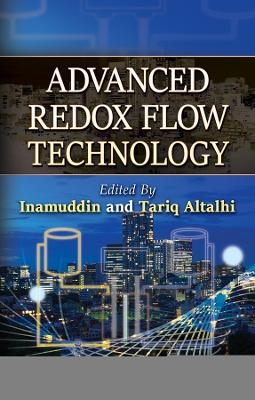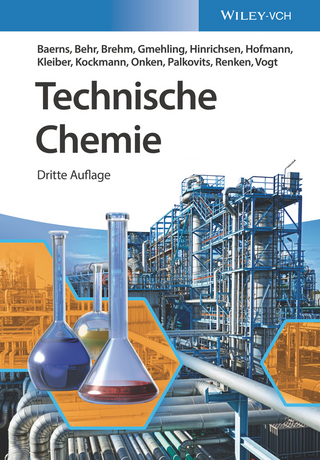
Advanced Redox Flow Technology
Wiley-Scrivener (Verlag)
978-1-119-90479-3 (ISBN)
- Titel ist leider vergriffen;
keine Neuauflage - Artikel merken
As energy becomes a greater global concern, redox flow technology must be considered as a possibility. There is concern over energy shortages and rising air pollution, paving the way for renewable energies like solar and wind energy which have been extensively analyzed and evaluated in recent years. These renewable sources, on the other hand, are intermittent and frequently unpredictably available, resulting in low-quality output energy and a negative influence on grid stability. To date, diverse types of energy storage systems have been designed for various purposes, each with its own set of benefits and drawbacks. In recent years, redox flow technology, particularly vanadium redox flow, has progressed substantially. Experiments at various scales have been successfully carried out, proving the viability of redox flow technology in bulk energy storage applications. In addition, innovative redox flow technologies that offer more energy storage per unit mass or a more cost-effective volume of the storage device have attracted a lot of interest.
This book is intended to serve as a comprehensive guide to redox flow technologies, from their basic principles to their applications. As a result, this book provides a thorough review of the craftsmanship in the subject, as well as the potential for future advances.
Advanced redox flow technology has sparked interest in bulk energy storage due to its flexibility in design, safety in operation, efficient energy storage, and near-zero environmental impact. The technology has been extensively developed and tested at a range of levels in recent years, demonstrating its applicability and usage.
Inamuddin, PhD, is an assistant professor at the Department of Applied Chemistry, Zakir Husain College of Engineering and Technology, Faculty of Engineering and Technology, Aligarh Muslim University, Aligarh, India. He has extensive research experience in multidisciplinary fields of analytical chemistry, materials chemistry, electrochemistry, renewable energy, and environmental science. He has worked on different research projects funded by various government agencies and universities and is the recipient of awards, including the Department of Science and Technology, India, Fast-Track Young Scientist Award and Young Researcher of the Year Award 2020 from Aligarh Muslim University. He has published about 210 research articles in various international scientific journals, 18 book chapters, and 170 edited books with multiple well-known publishers. His current research interests include ion exchange materials, a sensor for heavy metal ions, biofuel cells, supercapacitors, and bending actuators. Tariq Altalhi, PhD, is working as an associate professor in the Department of Chemistry at Taif University, Saudi Arabia, where he has served as the head of the chemistry department and vice dean of the science college. He has co-edited various scientific books and established key contacts in major industries in Saudi Arabia. His group is involved in fundamental multidisciplinary research in nanomaterial synthesis and engineering, characterization, and application in molecular separation, desalination, membrane systems, drug delivery, and biosensing.
Preface xi
1 Membranes for Redox Flow Batteries 1
Hridoy Jyoti Bora, Nasrin Sultana, Nabajit Barman, Bandita Kalita, Neelotpal Sen Sarma and Anamika Kalita
1.1 Introduction 1
1.2 Membranes Used in Aqueous Organic Redox Flow Batteries 6
1.2.1 Classification of Membranes Used in Aqueous Organic RFBs 6
1.2.1.1 Nafion-Based Membranes 6
1.2.1.2 Microporous Membranes 7
1.2.1.3 Anion-Exchange Membranes (AEMs) 7
1.2.1.4 Cation Exchange Membranes (CEMs) 8
1.3 Membranes Used in Non-Aqueous Redox Flow Batteries (NARFBs) 10
1.3.1 Stability of Membrane in Diverse Solvents 10
1.3.2 Ionic Permeability and Selectivity 11
1.3.3 Ionic Conductivity 12
1.3.4 Swelling 12
1.3.5 Mechanical and Chemical Stability 13
1.3.6 Cycling Performance 13
1.3.7 Classification of Membranes Used in NARFBs 14
1.3.7.1 Dense Membranes 14
1.3.7.2 Dense Ceramic Membranes 17
1.3.7.3 Porous Membranes 17
1.4 Ion-Exchange Membranes or Ion-Conducting Membranes for RFBs 18
1.4.1 Cation Ion Exchange Membrane (CEMs) 23
1.4.2 Anion Exchange Membrane (AEMs) 23
1.4.2.1 Preparation by Condensation Reaction of Ionic Monomeric Compounds 24
1.4.2.2 Preparation by Polymerization of Vinyl Monomers 24
1.4.2.3 Preparation from Conventional Polymers 24
1.4.2.4 Preparation by Plasma Polymerization 25
1.5 Polymer Electrolyte Membranes 26
1.5.1 Membrane Properties 27
1.5.1.1 Ion Exchange Capacity 27
1.5.1.2 Chemical Stability 27
1.5.1.3 Thermal Stability 27
1.5.1.4 Mechanical Property 27
1.5.1.5 Ionic Conductivity 27
1.5.1.6 Vanadium Ion Permeability 27
1.5.1.7 Water or Electrolyte Uptake 28
1.5.2 Transport Mechanisms 28
1.5.2.1 Proton Transport 28
1.5.2.2 Vanadium Ion Transport 28
1.5.2.3 Water (H2O) Transport 29
1.5.3 Membrane Preparation 29
1.5.3.1 Cation-Exchange Membrane (CEM) 29
1.5.4 Anion-Exchange Membrane 30
1.5.4.1 Polysulfone (PSF) 30
1.5.4.2 Poly(aryl-ether-ketone) (PAEK) 31
1.5.5 Amphoteric Membranes 31
1.5.6 Porous Membrane 31
1.5.7 Polybenzimidazole (PBI) 31
1.5.8 Polyacrylonitrile (PAN) 31
1.6 Amphoteric Ion-Exchange Membranes 32
1.7 Protonated Polybenzimidazole (PBI) Membrane 34
1.8 Summary 38
2 Electrolytes Materials for Redox Flow Batteries 51
Mandira Mitra, Sandip Kundu, Mousumi Layek, Subhodip Mondal, Ujjwal Mandal and Bidyut Saha
2.1 Introduction 52
2.2 Overview of Redox Flow Battery 53
2.3 Measurement of the Capacity of the Redox Flow Battery 54
2.4 Formation of Redox-Active Constituents for RFB 56
2.4.1 Inorganic Redox Flow Battery 57
2.4.1.1 All Vanadium RFBs 57
2.4.1.2 Zinc/Bromine RFBs 58
2.4.1.3 Tin/Bromine Redox Flow Battery 59
2.4.1.4 Iron-Chromium RFB 62
2.4.1.5 Polysulfide-Bromine RFB 63
2.4.1.6 Titanium-Manganese Redox Flow Battery 64
2.4.2 Organic Redox Flow Battery 65
2.4.2.1 Quinone-Based Redox Active Materials 67
2.4.2.2 Tempo-Based Redox-Active Materials 68
2.4.2.3 Redox Active Materials Based on Alkoxybenzene 70
2.5 Hybrid Electrolytes Used in a Lithium Redox Flow Battery 71
2.6 Levelised Cost of the Redox Active Materials 73
2.7 Conclusion 74
3 Zinc Hybrid Redox Flow Batteries 83
Srijita Basumallick
3.1 Introduction 83
3.2 Zn Electrode and Dendrite Formation 85
3.3 The Electrolyte 86
3.4 Effect of Temperature 87
3.5 The Membrane 88
3.6 Hydrogen Evolution Reaction 89
3.7 Conclusion 89
4 Zinc-Bromine Hybrid Redox Flow Batteries 91
M. Ramesh, J. Maniraj, D. Santhosh Kumar and S. L. Pradeep Kumar
4.1 Introduction 91
4.2 Electro-Chemical Energy Storage 92
4.3 Redox Flow Batteries 93
4.4 Zinc/Bromine Flow Batteries 95
4.5 Types of Zinc-Based Hybrid Flow Batteries 97
4.5.1 Zinc-Sulphur (Zn-S) Hybrid Battery 97
4.5.2 Zinc-Nickel (Zn/Ni) Batteries 97
4.5.3 Zinc-Sodium Hybrid Ion Batteries (ZSHIBs) 97
4.5.4 Zn-Ion Batteries (ZIBs) 98
4.6 Electrochemistry of Zinc/Bromine Deposition 98
4.6.1 Electrochemical Performance 98
4.6.2 Reduction of Dendrite Deposition 99
4.6.3 Bio-Mass Electrocatalyst 99
4.6.4 Surface Chemistry 101
4.6.5 Effect of Zinc Utilization 101
4.7 Applications of Zinc-Bromine Hybrid Flow Batteries 102
4.8 Future Challenges 102
4.8.1 Electric Vehicles 102
4.8.2 Energy Management 103
4.8.3 Size and Cost 103
4.8.4 Safety Measures 103
4.9 Conclusion 104
5 Zinc-Cerium Hybrid Redox Flow Batteries 107
Raghvendra Mishra and Rajendra K. Singh
5.1 Introduction 107
5.1.1 Redox Flow Batteries (RFBs) 108
5.1.2 The Basic Concept of Redox Flow Batteries 108
5.1.3 Progress and Challenges in the Redox Flow Batteries 110
5.1.4 Types of Redox Flow Batteries 111
5.1.4.1 Aqueous Redox Flow Batteries 111
5.1.4.2 Nonaqueous Redox Flow Batteries 114
5.1.4.3 Hybrid Redox Flow Batteries 115
5.2 Zinc-Cerium Hybrid Redox Flow Battery 117
5.2.1 Working Principle of Zn-Ce Redox Flow Cell 117
5.2.1.1 Components of Zn-Ce Redox Flow Battery 118
5.2.2 Factors Affecting the Performance of Zn-Ce Redox Flow Battery 120
5.2.2.1 Temperature 120
5.2.2.2 Electrolyte Flow Rate 121
5.2.2.3 Current Density 121
5.2.2.4 Charge Conditions and Cycle Life 122
5.3 Summary 122
6 Vanadium Redox Flow Batteries (VRFB) 127
Abrar Hussain, Muhammad Tahir Khan, Samad Yaseen, Ata-ur-Rehman and Syed Mustansar Abbas
6.1 Introduction and Overview 128
6.1.1 Working Principle of VRFB 130
6.1.2 Main Components of the VRFB System 132
6.1.2.1 Electrodes 132
6.1.2.2 Electrolytes 137
6.1.2.3 Membranes 140
6.1.2.4 Bipolar Plates 145
6.2 VRFB System as Compared to Other Energy Storage Systems 146
6.3 Recent Research on VRFB 148
6.3.1 Positive and Negative Electrodes 148
6.3.2 Electrolytes 149
6.4 Conclusion and Perspective 149
7 Vanadium-Based Redox Flow Batteries 161
Anurag Tiwari, Shishir Kumar Singh, Dipika Meghnani, Raghvendra Mishra and Rajendra Kumar Singh
7.1 Introduction 161
7.2 Redox Flow Batteries (RFBs) 162
7.2.1 The General Structure of RFBs 163
7.2.2 Working of Redox Flow Batteries 164
7.3 Types of Redox Flow Batteries 164
7.3.1 Iron/Chromium 165
7.3.2 All-Vanadium 166
7.3.3 Vanadium/Bromine 167
7.3.4 Bromine/Polysulfide 167
7.4 Vanadium Redox Flow Battery (VRFB) 168
7.4.1 Working Principle of Vanadium Redox Flow Battery 169
7.4.2 Role of Different Components in VRFBs 170
7.4.2.1 Role of Membrane 170
7.4.2.2 Role of Electrolyte 170
7.4.2.3 Role of Electrode 171
7.5 Applications of Vanadium Redox Flow Batteries (VRFBs) 171
7.6 Summary 173
8 System for the Redox Flow Technology 177
Shrabani Barman and Ujjwal Mandal
8.1 Introduction 177
8.2 General Construction of Redox Flow Battery 179
8.3 Energy Capacity 180
8.4 Optimization 181
8.5 Classification of RFB Based on Active Electrolyte 181
8.5.1 Inorganic Redox Flow Battery 182
x Contents
8.5.1.1 Vanadium Redox Flow Battery 182
8.5.1.2 The Iron Redox Flow Battery (IRFB) 184
8.5.1.3 Polysulphide-Bromine Redox Flow Battery (PBBs) 186
8.5.1.4 Zinc-Polyiodide Redox Flow Battery 187
8.6 Organic Redox Flow Battery 190
8.7 Membrane-Less RFB 193
8.8 Semi-Solid RFB 193
8.9 Conclusion 194
9 An Overview of Large-Scale Energy Storage Systems 199
Silas Saka
9.1 Introduction 199
9.2 Progression of Energy Storage Method 201
9.3 Categorization of Energy Storage System 204
9.3.1 Mechanical Energy Storage 204
9.3.2 Thermal Energy Storage 213
9.3.3 Electrostatic and Magnetic Energy Storage System 215
9.3.4 The Electrochemical Energy Storage System 219
9.3.5 The Chemical Energy Storage System 228
9.4 Implementations of Energy Storage Systems 236
9.5 Commercial Prototype of Energy Storage Systems 236
9.6 Environmental Repercussions of Energy Storage Systems 236
9.7 Energy Storage Guidelines 237
9.8 Blockades and Effective Solutions 237
9.9 Future Prospects 237
9.10 Conclusion 238
References 238
Index 245
| Erscheinungsdatum | 04.05.2024 |
|---|---|
| Sprache | englisch |
| Gewicht | 737 g |
| Themenwelt | Naturwissenschaften ► Chemie ► Technische Chemie |
| Technik ► Elektrotechnik / Energietechnik | |
| ISBN-10 | 1-119-90479-X / 111990479X |
| ISBN-13 | 978-1-119-90479-3 / 9781119904793 |
| Zustand | Neuware |
| Informationen gemäß Produktsicherheitsverordnung (GPSR) | |
| Haben Sie eine Frage zum Produkt? |
aus dem Bereich


